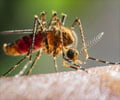New technique utilizing a combination of radiation and Wolbachia bacteria has been shown to effectively eradicate disease-causing mosquitoes and control the spread of deadly mosquito-borne diseases such as dengue and Zika.
- Novel powerful technique utilizing a combination of radiation and Wolbachia bacteria has shown promising results in eradicating disease-causing mosquitoes that are normally difficult to control
- The study used a combination of two existing methods namely, radiation-based sterile insect technique (SIT) and Wolbachia bacteria-based incompatible insect technique (IIT) to control the transmission of mosquito-borne infections such as dengue and Zika
- Following the use of the above measures, there was a significant decline in the number of disease-causing female mosquitoes (up to 94%) and a 97 percent reduction in mosquito bites suffered by local residents
Read More..
Using Radiation & Bacteria to Eradicate Mosquito Vectors
- The research team undertook a two-year trial at two locations in Guangzhou, which has the highest rate of dengue transmission by the Asian Tiger mosquito (Aedes albopictus) in China
- The number of hatched mosquito eggs sharply declined by 94%, and in some cases, not a single viable egg was detected for up to a 13 week period
- The average number of disease-transmitting female mosquitoes caught by traps declined significantly between 83-94%. In some cases, no female mosquitoes were found for up to six weeks
- There was a fall of nearly 97% in mosquito bites suffered by local residents, which made them more receptive to the research team’s plan of releasing mosquitoes into the test sites
According to lead author Zhiyong Xi, a professor at Michigan State College’s Division of Microbiology and Molecular Genetics, “In contrast to the approach to “producing insecticide, our objective is to make use of this method to construct a protected space that’s illness vector-free.”
How Do Radiation & Wolbachia Bacteria Control Mosquitoes?
The study employed two existing techniques, namely radiation-based sterile insect technique (SIT) and Wolbachia bacteria-based incompatible insect technique (IIT) to stamp out the disease-carrying mosquitoes.- In the SIT method, male mosquitoes sterilized by radiation are released into the environment to mate with wild female mosquitoes, resulting in the reduction of the mosquito population, since the female mosquitoes fail to reproduce
- The IIT method uses Wolbachia bacteria, which mainly hinders the insects' ability to reproduce. Male bacteria are infected with Wolbachia bacteria, and following this, when they mate with female mosquitoes, the resulting eggs are not viable
Combining Radiation & Wolbachia Bacteria Methods to Eliminate Mosquitoes
To overcome the drawbacks of each of the above methods used separately, the team decided to subject Wolbachia infected test mosquitoes to low-level radiation. This resulted in the sterility of female mosquitoes, but allowed the males to reproduce.The above method enabled the research team to release more number of mosquitoes into the environment of more than 160,000 male mosquitoes per week per hectare.
Potential Demerits of the Method
The results were not successful universally. In areas with heavy traffic, close to construction sites or roads, etc., the numbers declined to a lesser extentcompared to that in remote areas, probably since mosquitoes migrated in from outside.However, Xi states that the approach might be still effective if used in locations such as highways to control the migration of mosquitoes from outside.
Scope of Study & Future Plans
- Can be used against mosquitoes causing malaria as well
- Further research is needed to develop an effective mosquito release technique suited to urban locations
Reference:
- Incompatible and sterile insect techniques combined eliminate mosquitoes - (https://doi.org/10.1038/s41586-019-1407-9)
Source-Medindia










